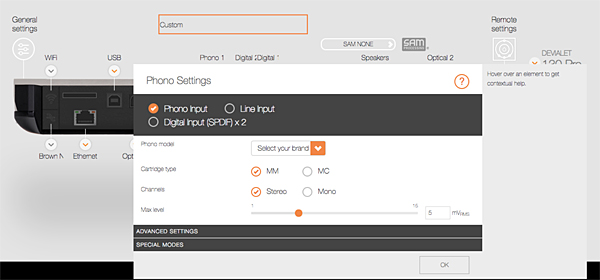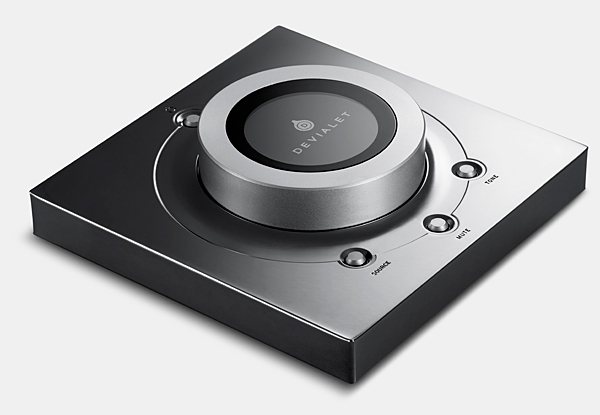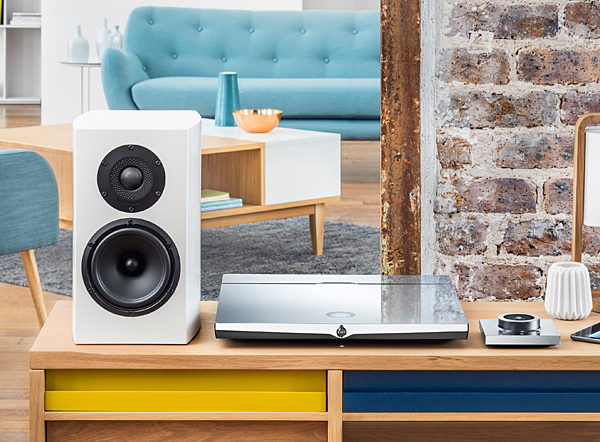| Columns Retired Columns & Blogs |
and it costs 3K USD

Accomplishing these things is a multistep process. First, you visit Devialet's website and locate the Configurator app. You create an account and sign in. You choose specific settings from an image on the website of your Expert Pro's back panel—just click on icons and make choices. Once you've set things up the way you want them, you save the Configurator file to an SD card—so you'll need an SD card reader. When you plug the card into a slot on the Devialet's back panel, your Expert Pro is immediately reconfigured.
Not every function is set in that manner. Others are adjusted by interacting with the chassis via the remote control: Hold down a button for a couple of seconds and then use the volume knob—monitoring the display on top of the chassis—to make choices.
Listening
When I first started up my review sample, "RoonReady" was the default input choice. Once I had plugged in an Ethernet cable and set up the 140 on my network, I went in to Roon Settings, found the Expert Pro, and chose it as an endpoint. It was time to play some music.
The first thing I played was the first track on Cécile McLorin Salvant's Dreams and Daggers (Mac Avenue MAC1120)—a very familiar cut—delivered via Ethernet and decoded by the Devialet's internal DAC. I immediately noticed a remarkable sense of openness compared even to the excellent amplifiers I'm accustomed to using. Low- frequency extension and weight were impressive. This is not a rich, buttery, midrangey amplifier. It is honest, evenhanded, liquid, open.
Dreams and Daggers is a good-sounding recording, but it is unchallenging; it sounds great on many systems. I needed a more serious challenge.
I switched to Movement V—Im Tempo des Scherzos—from the Benjamin Zander/Philharmonia recording of Mahler's Symphony No.2 (Linn Records CKD-452, 24/192 ALAC download). Mahler gets right to it in that movement, with a massive climax just 15 seconds in. Consider, for a moment, the nature of this system I'm using: Yes, these Revel Salon2 speakers are fairly large, but otherwise the only components are the circa 12lb Expert Pro, an Intel NUC that weighs a few ounces, an Ethernet cable, and some speaker wire—no 100lb class-A monoblocks in sight.
The sound was broad, deep, massive.
Sonata, John Atkinson's recording of Robert Silverman playing Liszt (FLAC rip from CD, Stereophile STPH008-2), is among the most natural-sounding piano recordings I know. The major work on this record is the B-minor Sonata, S.178, a piece that has been recorded by several respected audiophile engineers—including Keith Johnson, who engineered Nojima's version (24/176.4 FLAC download, Reference Recordings 25), another favorite. Both recordings present a mid-hall perspective. JA's recording digs out a little more of the sound of the Steinway, while the Nojima has a rather more precise piano image.
Also on JA's Liszt disc is Orage, for piano (S.160); lately I've been using it more in component evaluations than the B-minor sonata, because it involves a good bit of key-pounding; how well does a system capture that sound? With the Devialet in the system, serving as DAC, preamp, and amplifier, Orage sounded grand and appropriately percussive with intensely satisfying, stirring deep-bass notes.

After the Liszt came "Mezzanine," from the album of the same name by Massive Attack (CD-rez FLAC, via Tidal), which sounded huge, again with intense deep bass. "Night Life," from Bad Influence's album Live at the Bad Habits Café (FLAC rip from CD, WildChild! 03152), was recorded by Mapleshade's Pierre Sprey and reviewed by the late Wes Phillips: I listen to this partly for the imaging but mainly for a party and a good buzz—literally—especially from the tenor sax but also from the vocals. This recording really captures timbre well.
There was slightly less of this (desirable) buzz from the tenor sax here than I hear with some straight class-A amps. I like texture—a lot—but it's likely that the Devialet's rendering is the more technically accurate one. (I'm speculating.) In any case, through the Expert 140 Pro, stereo images on that recording were always razor-sharp, occupying the loudspeaker plane and well back from there.
I made some direct, volume-matched comparisons, first with the Expert Pro doing the conversion vs the Mytek Brooklyn Bridge sending its analog output to the Expert Pro's line input—so, two extra conversions (D/A then A/D) in this signal path. Whether it's because of the extra conversions or because the Devialet's DAC is better, the simpler (Devialet-only) system won on points: transients were sharper with the Expert Pro–only system.
Later, I compared the Expert Pro to a reference system consisting of the Mytek Brooklyn Bridge, the Pass Labs XP-22 preamplifier (Stereophile's Amplification Component of the Year for 2019—see the article elsewhere in this issue), and the Pass Labs XA60.8 monoblock amplifiers (Stereophile's Joint Amplification Component of 2018). That's the $6490 Devialet vs $25,000 worth of components (plus the cost of two sets of interconnects). The Mytek/Pass Labs reference system sounded noticeably darker and richer, with more body, but there wasn't more deep bass. I love the sound this reference system makes, but the Devialet system measured up well—liquid and unperturbable.
SAMIam
The most interesting implementation of DSP in the Expert Pro is what Devialet calls SAM (with a trademark sign of course), for speaker active matching. Devialet uses a laser interferometer to measure the response of loudspeakers' low-frequency drivers and compares the results to an electrical test signal. They use this information to engineer DSP corrections specific to your loudspeakers. Part of this is adjusting for phase delay at the low end of the frequency range—any time a driver is rolling off, its phase is also changing—but apparently that's not all.

SAM has a level control you can access by holding down a button on the remote. You can set it anywhere from zero to 100%. Devialet told me that time-domain corrections are always done, even at 0% SAM. This SAM setting, they said, controls amplitude corrections—but only low-frequency extension: at higher frequencies, volume levels should always remain flat. That wasn't my experience.
I set SAM at 100%, set the volume moderately loud, and played a 20Hz warble tone and toggled SAM on and off. With SAM disabled, the 20Hz signal wasn't loud; with SAM activated, windows rattled at the far end of the room, some 40 feet from the loudspeakers, something I've never before experienced in this room. That's convincing evidence that SAM does, as claimed, increase low-frequency extension. (Revel claims frequency response down to 26Hz; Devialet says SAM can increase it—safely—to 13Hz.)
With the 31.5Hz warble tone, there was no perceptible change in volume, but there was audible beating with SAM turned off; I turned SAM on, the beating went away.
Here's an odd thing though: With SAM at 100%, with the digital version of the new Giles Martin/Sam Okell Abbey Road remix, there was too much bass—not just at the low end but also well into the range of a bass guitar. I made some measurements to confirm: At certain frequencies—not all—up to about 100Hz, pure-tone test signals were louder with SAM engaged. When I asked Devialet about this, they proposed it had to do with room interactions, which I don't understand. In any case, dialing SAM back to below about 40% solved the problem.

SAM is interesting and fun to play with. I didn't mention it in the listening section, but I heard quite significant improvements in the sound with SAM engaged, in bass articulation in particular, especially in complex orchestral passages. I'd like to learn more about it, and I'd like to play around with it more.
It's a wrap
I wish the Expert Pro 140 came in a finish other than Dark Chrome. I wish its setup scheme were simpler. I wish there were more buttons, especially on the remote, so that it wouldn't be necessary to choose between, say, controlling phono-stage parameters on the fly and a mute button. I wish setup could be carried out entirely from an app, without requiring an SD card. Then again, none of this need be a problem for you: If setup sounds intimidating, just let your dealer do it.
Anyway, those disadvantages pale compared to the Expert Pro 140's overall excellence: It sounds immaculate—in the top tier of amplifiers I've heard. It's dynamic. The 140 may be the least powerful Expert Pro, but it drove the Revel Salon2's with apparent ease. SAM is a fascinating technology, a new parameter to play with, and it can genuinely improve the sound.
There surely are hardcore analogphiles among Stereophile's readers who won't be interested in the Expert 140 Pro because it digitizes incoming analog signals . It's not for people who need more than one analog input, nor those who don't like shiny chrome. It is, however, for anyone else who wants versatility and remarkable sound in a compact package.
The Devialet Expert 140 Pro is an easy recommendation for anyone who appreciates its approach and aesthetic.

and it costs 3K USD

Keep in mind that’s just a power amp. But yes, you can get better measured performance for cheaper.
The Outlaww RR2160 that Stereophile measured is <$1000 and has excellent measurements for the price, and it has subwoofer crossover filters, pre-out/main-in for DSP, tone controls, balance controls, etc.

...is no more valuable than when a tossed off opinion invalidates all prior work. When in the market I always dive straight to comments!


Even with pre-amp it is cheaper and MUCH MUCH better.

It would be interesting to see, the in-room frequency response measurements of Devialet Expert Pro with SAM, from the listening position of JCA (if, possible), with and without SAM engaged :-) ........

TAS also reviewed one of the models of Devialet Expert Pro with SAM ....... That TAS reviewer also had similar listening experience with his speakers as JCA ....... That TAS reviewer discussion about the significance of bass frequencies on the overall sound quality is an interesting read :-) .......

The wave length of 20 Hz frequency is 56 feet ...... The wave length of 40 Hz frequency is, half of that, 28 feet ....... No wonder, JCA's windows 40 feet away rattled with loud 20 Hz frequency ...... It also goes to show the bass capabilities of the Revel Salon2 :-) .......

Some of that 'too much bass' JCA heard when playing bass guitar, could be due to 'Allison effect' ........ Another good reason for obtaining in-room FR measurements of JCA's listening room :-) ........

Seems like this Devialet Outfit is showing us what the future will be for us Home Music Reproducers. ( from now on )
I've been building Music systems for a very long time, getting not so good results, spending exaggerated sums of money, trying to have fun doing it and constantly searching for "NEEDED" improvements.
Back 1963ish, when I owned a Mcintosh MC40, I'd kinda thought that Audio Gear needed to be bigger to be better. Ideas like a Devialet Amp would be SciFi exaggerations .
Egads..
Now, Devialet is reality. Pinch me, I lived to see it, I won! ( we're all winning )
Tony in Venice
ps. from now on, Home Audio Systems are probably better than my hearing.

Seems like this Devialet Outfit is showing us what the future will be for us Home Music Reproducers. ( from now on )
I've been building Music systems for a very long time, getting not so good results, spending exaggerated sums of money, trying to have fun doing it and constantly searching for "NEEDED" improvements.
Back 1963ish, when I owned a Mcintosh MC40, I'd kinda thought that Audio Gear needed to be bigger to be better. Ideas like a Devialet Amp would be SciFi exaggerations .
Egads..
Now, Devialet is reality. Pinch me, I lived to see it, I won! ( we're all winning )
Tony in Venice
ps. from now on, Home Audio Systems are probably better than my hearing.

It also has a built-in DAC, plus about the same power output as this Devialet unit - but at one-quarter the price.
https://audio.com.pl/testy/stereo/wzmacniacze-stereo/2855-denon-pma-1600ne
The Denon product also won a Hi-Fi Choice group test:
https://files.hifiklubben.com/4a500a/globalassets/tester/denon/2017/pma-1600ne-hfc-group-test-verdict.pdf

Can it rattle the windows? ....... It doesn't have SAM and DSP ....... It does't have built-in Wi-Fi access capabilities :-) .......

... is it "liquid and unperturbable"?

Denon PMA-1600NE does keep the analog signal in analog domain ....... So, if you are an analog fan and use tube phono pre-amp, then the Denon could be 'liquid and unperturbable' :-) ......

Wow. Given the hype behind Devialet's products, I expected this box to measure a lot better than it did.
I agree with the first poster about the AHB-2. Also, Bruno Putzeys' work with nCore & Purifi show that you can have Class D with vanishingly low levels of noise and distortion.
I'd be interested in you guys getting a NAD M32 on the bench. It's a very similar product.
It would seem to me that having this much noise (-80dB @ 1 watt) in a product regardless of its linearity and lack of distortion would leave a veil of haze on everything.
A decade ago, I owned a Sony TA-E9000ES digital pre-amp. In spite of it's fantastic tone controls, listening modes and alleged lineage from Sony's Oxford mixing board (which I seriously doubt), the unit was really noisy. Just like this unit. And then, one day, it just died.
I could never truly enjoy my listening experience because of the constant noise which was about 85-90dB below maximum output.
For a little less money, you can get Benchmark's AHB-2 amp & DAC3 as well as a MiniDSP Dirac processor. That will give you everything the Devialet offers, but the phono pre. You will, though, gain room correction on top of speaker correction. So long as you don't need analog inputs, you'd be getting much better performance.

Stereophile has already reviewed NAD M32 :-) .........

Bench-racing technophiles are never gone long. Too much correcting of the legions of rubes in audio remains to be done.
It's audio virtue signalling. Its ultimate expression is to reduce all audio down to about six components, none of which actually need to be experienced, much less enjoyed.

NAD M10 ($2,750) ...... Stereophile review coming soon :-) .......

NAD M10 has 2 subwoofer output connections :-) .......

The streamer functionality belongs on a separate device than can be replaced or upgraded separately from the longer life hardware (DAC, control preamplifier, power amplifier, etc.).


See Stereophile review and measurements, January 2020 issue :-) .........

Likewise I'm surprised by that 1W distortion result of ~0.2%.
Not saying this is audible of course, just that there are many amps in the Class D world capable of better than that from an engineering perspective for less money.

Well ....... Better than twice as expensive BorderPatrol power-amp :-) .......

If you consider integrated amps between $5k and $10k, more powerful 220 Expert Pro with SAM ($9,990) is also available ...... 220 Expert Pro was TAS 2019 'Golden Ear' award winner :-) ......

More powerful 300 WPC McIntosh MA9000 integrated amp is $10,500 (reviewed by Hi-fi News) ........ MA9000 has 8 band parametric EQ :-) .......

"analog signals deteriorate in ways that digital signals don't, as long as they (the digital signals) remain error-free, which technology itself can assure."
This is a ridiculous statement,particularly the final part.

Is ridicule necessary or appropriate?
Audio engineering in France has been at a consistently high level.
Tony in Venice

and self-apparently so. Very simply, digital signals have dual "natures". They exist as an analog electrical signal and as data--information. The latter aspect of their nature is of course the "digital" part; "digital", used this way, refers to the fact that each piece of information exists in one of two levels, up or down, 1 or 0, 0V or 5V, or what have you. The integrity of their digital nature can be assured with error checking--as anyone who has ever copied a CD with EAC, or done a bit-perfect test on a digital audio stream, can attest.
So while all analog signals degrade--including those representing digital data--the digital aspect of their nature in general "remain error-free," even as that degradation occurs. It is of course possible for those signals to degrade to the point where the integrity of the digital data is compromised, but this rarely happens in a properly functioning audio system.
And before you start lecturing us about jitter, bits not being just bits, and all that, please know that I'm aware of it, but it in no way contradicts what I wrote. And please notice this phrase from the review: "as long as those A/D and D/A conversions are done with great care."
Jim Austin, Editor
Stereophile

Excellent summary of the situation and clarifying the true nature of digital.

...was not addressing the equipment under review. The language I quoted distinctly reminds me of the "perfect sound forever" line we were sold by companies and reviewers way back when. It was not true then and remains untrue.

What I wrote--what you called "a ridiculous statement--was true, and it remains true.
Jim Austin, Editor
Stereophile

What you stated is a theoretical ideal - one that is never fully attained.

Jim's sentence: "Devialet's designers believe — in this they are correct — that analog signals deteriorate in ways that digital signals don't, as long as they (the digital signals) remain error-free, which technology itself can assure."
It's obviously true on a routine basis due to digital error detection and correction. If this were not, we would not be communicating with confidence that the Internet is conveying the same message across thousands/millions/billions of screens, your computer would not be able to run at >1GHz, the gigabytes of RAM would be unreliable, and terabytes of music on hard drives would be suspect.
Enough with the hand wringing and nonsense unless you have evidence to show that this were not so.

If you have been brainwashed by Pastafarian cultists into believing in the existence of the Flying Spaghetti Monster, it will be very difficult to reprogram your thinking and convince you that your deep dish plate of frutti di mare fra diavolo is merely the main course of your dinner and not the Pastafarian Holy Eucharist. ...perhaps more especially when the eating feels much like some sort of reborn religious experience.


Man, you are making me hungry :-) ......

...perhaps I should have reworked that to utilize bouillabaisse, loaves and fishes instead.


Sorry .... We will just settle for either country ham and grits or, fried chicken and grits ....... Or, may be just Buffalo wings and Budweiser :-) .......


Country ham and grits is the secret to success, the Alabama Crimson Tide had all these years ....... Alabama native Tim Apple also owes his success to country ham and grits :-) ........

Well, while I didn't exactly grow up in Alabama--we left when I was 4--most of my family was still there so we visited often, several times a year. But I did not discover true country ham--salt cured--until we started vacationing in North Carolina and Virginia. So I feel comfortable saying that it's not so much an Alabama thing.
Jim Austin, Editor
Stereophile

True .... Lot of southern states restaurants serve country ham and grits, and shrimp and grits :-) .......

If you like seafood, shrimp and grits is also excellent :-) ........

Is that French baguette with that bouillabaisse? ....... Actually, JCA likes French baguette ....... Now we know how Devialet got a favorable review :-) .......

I think the owners of the Devialet gear and the Benchmark gear should gather together with said gear and have a small party. Bet everyone comes away happy.
Now, the reference to Pastafarians got me. I recall a few years back a dispute in the local media of a Western Canadian city - the Province was refusing to issue a drivers licence to an individual because of his photo.
The official photo was of the individual wearing of his religious headgear that consisted of a plastic colander (!). Personally, I was good with it, it showed his features, and apparently a willingness to cope with linguini at any moment.
Hope he got his licence.

M2Tech Joplin Mk III DSP-based phono stage. It's possible that this is a remarkable phono preamp based on the architecture. A thorough bench test and audition would have real value.